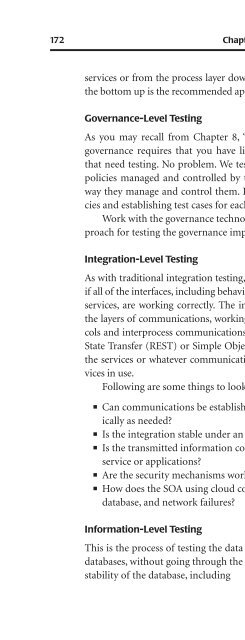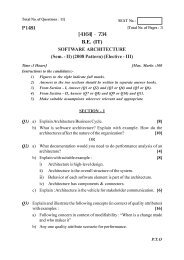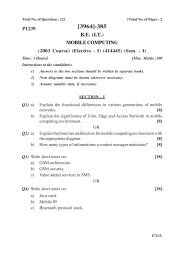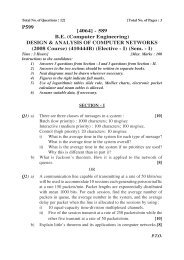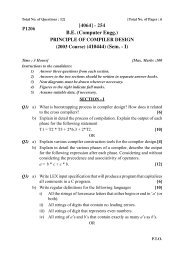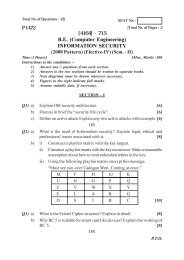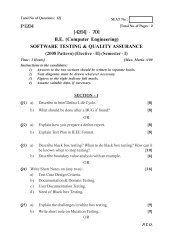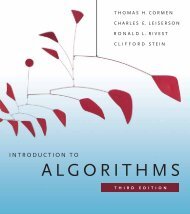Cloud Computing and SOA Convergence in Your Enterprise: A Step ...
Cloud Computing and SOA Convergence in Your Enterprise: A Step ...
Cloud Computing and SOA Convergence in Your Enterprise: A Step ...
You also want an ePaper? Increase the reach of your titles
YUMPU automatically turns print PDFs into web optimized ePapers that Google loves.
172 Chapter 9 Test<strong>in</strong>g from <strong>SOA</strong> to the <strong>Cloud</strong>s<br />
services or from the process layer down to the primitive services. Go<strong>in</strong>g from<br />
the bottom up is the recommended approach.<br />
Governance-Level Test<strong>in</strong>g<br />
As you may recall from Chapter 8, “Br<strong>in</strong>g<strong>in</strong>g Governance to the <strong>Cloud</strong>s,”<br />
governance requires that you have lifecycle <strong>and</strong> policy management layers<br />
that need test<strong>in</strong>g. No problem. We test governance systems by match<strong>in</strong>g the<br />
policies managed <strong>and</strong> controlled by the governance system with the actual<br />
way they manage <strong>and</strong> control them. It is a simple matter of list<strong>in</strong>g the policies<br />
<strong>and</strong> establish<strong>in</strong>g test cases for each.<br />
Work with the governance technology provider to determ<strong>in</strong>e the best approach<br />
for test<strong>in</strong>g the governance implemented <strong>in</strong> the system.<br />
Integration-Level Test<strong>in</strong>g<br />
As with traditional <strong>in</strong>tegration test<strong>in</strong>g, the purpose of this step is to figure out<br />
if all of the <strong>in</strong>terfaces, <strong>in</strong>clud<strong>in</strong>g behavior <strong>and</strong> <strong>in</strong>formation shar<strong>in</strong>g between the<br />
services, are work<strong>in</strong>g correctly. The <strong>in</strong>tegration test<strong>in</strong>g should work through<br />
the layers of communications, work<strong>in</strong>g up through the network to the protocols<br />
<strong>and</strong> <strong>in</strong>terprocess communications, <strong>in</strong>clud<strong>in</strong>g test<strong>in</strong>g the Representational<br />
State Transfer (REST) or Simple Object Access Protocol (<strong>SOA</strong>P) <strong>in</strong>terfaces to<br />
the services or whatever communication mechanism is employed by the services<br />
<strong>in</strong> use.<br />
Follow<strong>in</strong>g are some th<strong>in</strong>gs to look for <strong>in</strong> <strong>in</strong>tegration-level test<strong>in</strong>g:<br />
Can communications be established with late b<strong>in</strong>d<strong>in</strong>g, mean<strong>in</strong>g dynamically<br />
as needed<br />
Is the <strong>in</strong>tegration stable under an <strong>in</strong>creas<strong>in</strong>g load<br />
Is the transmitted <strong>in</strong>formation correct <strong>in</strong> semantics <strong>and</strong> content for the<br />
service or applications<br />
Are the security mechanisms work<strong>in</strong>g properly<br />
How does the <strong>SOA</strong> us<strong>in</strong>g cloud comput<strong>in</strong>g recover from application,<br />
database, <strong>and</strong> network failures<br />
Information-Level Test<strong>in</strong>g<br />
This is the process of test<strong>in</strong>g the data persistence layers directly, typically the<br />
databases, without go<strong>in</strong>g through the services. We look at the efficiencies <strong>and</strong><br />
stability of the database, <strong>in</strong>clud<strong>in</strong>g


